Foraging wild food requires practice, knowledge, and experience on your landscape. Notice I used the word your land. What you’ve read in books and watched on YouTube may not apply to your locale. While survival principles may never change, self-reliance is local.
Many of us are self-taught in skills of wilderness living. However, one way to shorten your learning curve is to find an experienced skills practitioner in your area who is actually Doing the Stuff. After receiving instruction, you gain knowledge. Knowledge weighs nothing but is not enough. You make knowledge applicable through time and experience and context. There is no substitute for time in your woods.
I had the recent pleasure of attending my third class at Medicine Bow, A Primitive School of Earthlore in the North Georgia Mountains. If you look up Renaissance Man in the dictionary, Mark Warren’s bio should appear, but won’t. He’s not only a walking encyclopedia of woods-lore, he won the U.S.National Champion in Slalom/Downriver combined and the World Championship Longbow Tournament in 1999. On top of his wealth of outdoor knowledge, he is also a musical composer and published author.
Mark’s knowledge of the Cherokee uses of plants and trees is the foundation for anyone interested in wilderness living and self-reliance. I wrote him an email after the class asking assistance on a question for this article. I wanted to know the degree to which Cherokees depended on domesticated crops verses wild foods.
Mark’s response:
“Everyone knows about Cherokee farming and the 3 sisters (corn, squash, and beans), but the wild growth of forest and field was actually “farmed” too, by pruning or clearing for light. For example, swamp dogwoods were pruned to encourage survival shoots for basketry and arrow shafts. Large areas along flood plains were burned to help create a monopoly of river cane (for the same two crafts). A lot of those “brakes” can still be seen. The same is true of foods. I have a sense of why Amicalola was sacred to the Cherokee. I suspect it was for the prolific sochani that grows there. It’s also called green-headed coneflower. Cherokee women in NC still harvest it in spring and freeze for the year.”
Click here for more information on Sochani (Green-Headed Coneflower).
Related: A True Survival Story: “Taking Their Possessions and Some Seeds, They Had Retreated Ever Deeper Into the Forest”
Think about this astounding bit of research…
“The Cherokees of the 19th century are listed as having around 800 plants in their repertoire (Mooney, 1992). This from a pool of about 2,400 species of plants to work from or about a third!” ~ Source
Every year I add more plants and trees to my food-medicine-craft list. But 800! I’ve got a lot to learn and experience.
“In the school of the woods, there is no graduation day.”
~ Horace Kephart
Trees of Southern Appalachia
Wild plant foragers get excited this time of the year. Green shoots make their way through the soil for another growing season. Autumn turns to winter and the smorgasbord disappears. But trees, they stand ready to share their resources year-round.
Winter tree identification would not be challenging if trees would stop dropping their leaves. Mark taught winter botany lessons which I had never been exposed to. Sharing all I learned would take several articles. For our purposes today, we will explore 3 of my favorite trees in my woods and how the Cherokee and settlers used them for food, medicine, and craft resources.
Tulip Tree
Tulip Poplar (Liriodendron tulipifera) it is not a poplar at all. It is actually in the Magnolia ((Magnoliaceae)) family of flowering trees. There are many common names for Liriodendron tulipifera besides Tulip Poplar… Yellow Poplar, Canoe Wood, Yellow Wood, and Tulip Tree. That is one reason it is important to use scientific names of plants and trees… if you can manage to pronounce them. This will remove any confusion over common names.
Related Resource: Trees for Self-Reliance
Food
The Tulip Tree, while not a nutritional powerhouse, is a favorite of mine mainly for craft and outdoor self-reliance. Tulip Tree blooms are a main source of nectar for honey bees which produces a dark, amber honey loaded with antioxidants.
- The only part of a Tulip Tree that I know is edible is the nectar in the flowering blooms.
- Edit: Darryl Patton, The Southern Herbalist, sent me a message saying he collects, dries, and pounds the inner bark into flour for baking in his spring classes. Thank you, Darryl.
Medicine
Tulip Tree’s inner bark and leaves were used medicinally by the Cherokee and settlers in Appalachia for treating…
- Poultice from leaves for inflammation and sores.
- Inner bark tea for periodic fevers, diarrhea, pinworms, as a digestive aid and for rheumatic pain.
- Supposedly, inner bark was chewed as an aphrodisiac.
- The bark could also serve as a substitute for quinine in treating malaria.
- Tooth aches.
- Used as a tonic to induce perspiration to treat fevers.
- Root bark and seeds useful as a wormer for the body.
- Cough syrup from bark.
Craft
- Fire Craft ~ Wood for friction fire, inner bark for tinder, hot, quick burning firewood which does not produce long-lasting coals like other hardwoods.
- Cordage ~ Inner bark fibers can be processed into cordage and rope.
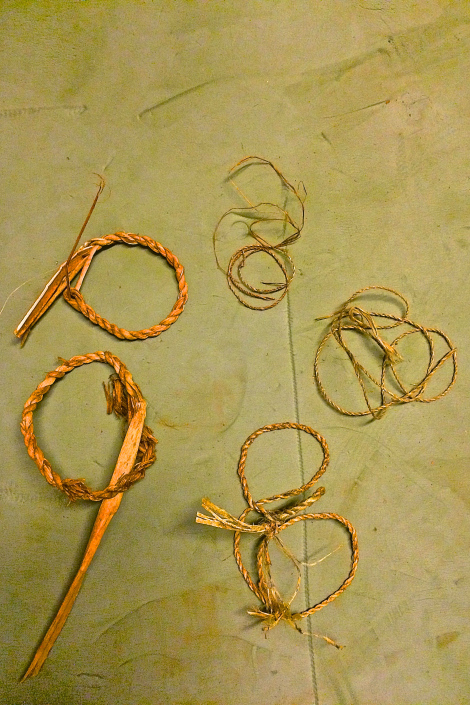
Indigenous cordage: Clockwise from 12:00 ~ Dogbane; Tulip Tree; Okra, and Yucca.
- Containers ~ Outer bark crafted into berry baskets, arrow quivers, and larger pack baskets.
- Carving ~ The soft hardwood lends itself to easy carving of spoons, bowls, pottery paddles, canoe paddles, and even the canoe itself. One common name of this tree is Canoe Wood.
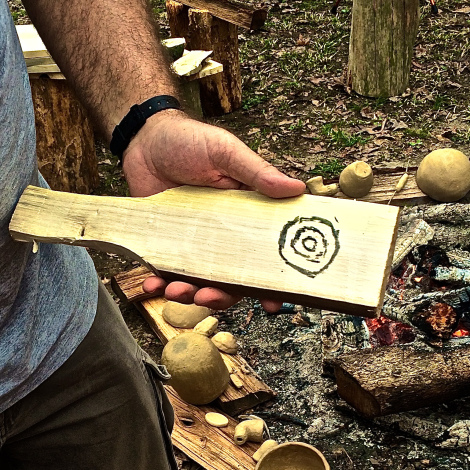
This design will be carved into the Tulip Tree paddle and used to imprint designs on primitive process pottery.
- Insulation ~ Shredded inner bark can be stuffed between layers of clothing to create dead air space to retain body heat in a survival situation.
- Roofing/Siding ~ Outer bark slabs used for shingles and siding on shelters.
Hickory
Hickories make excellent wildlife resource as squirrels and feral pigs love to eat their nut meat. Pignut (Carya glabra), Mockernut (Carya tomentosa), and Shagbark (Carya ovata) are the three hickories I’m most familiar with in Georgia, Mockernut being the most common.
Related: 15 Top Wild Edibles That Can Save You in the Wild
Food
- Sap ~ Sap water from hickories can be consumed without treatment.
- Nuts ~ Contains fats (18g/serving), protein (3.6g/serving), and carbohydrates (5 g/serving) – Serving size = 1 oz.
- Hickory syrup from crushed and processed nuts.
- Cooking oil from nuts.
- Kunuche (ku-nu-che) ~ A traditional Cherokee hickory nut soup.
- Nuts with exterior husks are useful as charcoal for cooking food.
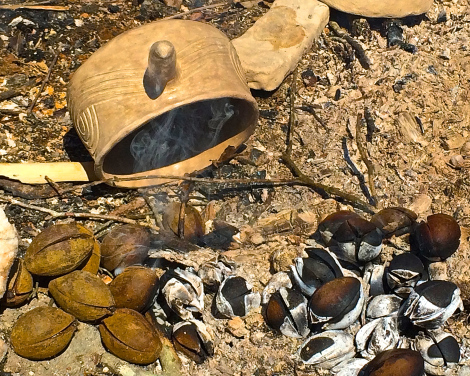
Scott Jones (Media Prehistoria) using hickory nuts as charcoal.
- Hickory Milk ~ “They pound them to pieces, and then cast them into boiling water, which, after passing through fine strainers, preserves the most oily part of the liquid; this they call by a name which signifies hiccory milk; it is as sweet and rich as fresh cream, and is an ingredient in most of their cookery, especially homony and corn cakes.” – Source
Medicine
- Infusion of boiled bark for arthritis pain.
- Inhaling fumes of young shoots on hot rocks as a treatment for convulsions.
- Cold remedy
- Liver aid
- Gynecological aid
- Dermatological issues
Craft
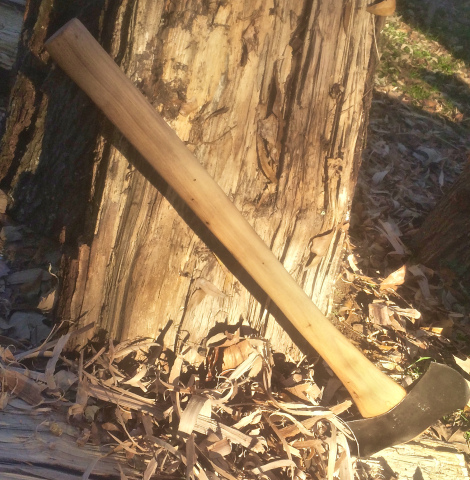
This ax handle started out as the hickory tree pictured in the background
Hickory was used by the Cherokee’s for…
- Stickball sticks
- Crafting bows
- Handles – (Here’s my tutorial on carving an ax handle from hickory)
- Firewood
- Smoking meats
- Furniture
- Inner bark of Mockernut and Shellbark Hickory used to finish baskets
- Ashes from hickory were used by settlers to make quality lye for soap.
- Inner bark used for cordage. Mark described a method of slicing down a hickory limb to remove the bark and twisting it to make a strong rope. I’ll explore that method in a later post.
- Green nut husks used as dye – (My bed sheet tarp was dyed with hickory and black walnut dye)
- Nut oil mixed with bear fat as an insect repellent.
Pine
There are 36 pines in North America to choose from. These evergreens are easy to spot for anyone. To narrow down the species, count the needles. The Eastern White Pine (Pinus strobus) is the only species with 5 needles in the fascicle sheath (the paper-like sheath surrounding the base of the needles).
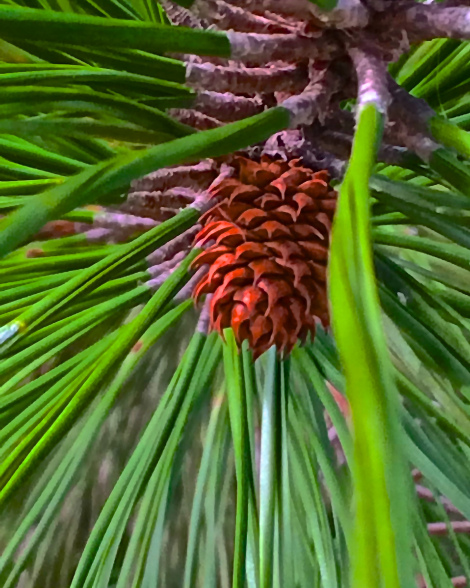
Hemlock is a part of the pine family and grows in southern Appalachia. Like other pines in our region, the inner bark is edible.
Food
- Pine nuts are edible and tasty.
- Inner bark was eaten when other foods were scarce. Should be boiled/cooked since it is high in turpenes. Can also be dried and ground into a flour.
- Pine pollen can be collected and is edible and used like flour.
- Long strips of inner bark can be boiled to make pine noodles.
Medicine
- Pine needle tea has the following medicinal properties: antiseptic, astringent, inflammatory, antioxidant, expectorant, high in Vitamin C for colds – flu – coughs, congestion, and even scurvy.
- Shikimic acid, the main ingredient in Tamiflu, is harvested from pine needles in Asia.
- Pine resin applied to skin conditions.
- Arthur Haines describes on his YouTube channel how pine pollen provides multiple avenues of protection against radioactive cesium.
- Warm poultice of pine resin will draw splinters and foreign matter from skin.
- The inner bark can be fashioned as an antiseptic Band Aid for cuts and scraps
- Chew softer sap straight off the tree like a gum for sore throats and colds. You could pre-make “gum” with these ingredients: bees-wax, pine sap, and honey.
Related: The Ultimate Primitive Torch When You Need Hours of Fire
Craft
- Pine sap/resin ~ Click here for 16 uses of pine resin from an earlier post.
- Fire Craft ~ My favorite fire starter. Resin-rich fat lighter produces a chemical burn for fire lighting.
See more useful fire craft articles on our Bombproof Fire Craft page.
- Wood for shelters and bows for bedding.
- Rescue Signals ~ A pre-made signal fire built with green pine boughs on top will generate enough white smoke to be seen for miles.
- Pine needles were used to make baskets and resin was used as a sealer.
- Logs were used in home building.
- White pine and hemlock are both good wood for friction fire.
- Dried and ground hemlock inner bark used as flour.
- Dried pine “flour” is useful when rubbed on the body to cover human scent while hunting.
Mark says that Cherokees called trees “The Standing People.” Trees do not walk to new locations like animals in search of food. They are always in the same spot. Learning to identify trees and their resources will put you in a better position of appreciation and stewardship of your natural environment.
To mention all the trees used by the Cherokee would be better addressed in book form. In this article, we’ve highlighted three of my favorite trees in our woodlands. I’ll write future blogs covering more. Here’s a teaser on future posts… Dogwood, Sourwood, Basswood, Black Walnut, Persimmon, Beech, Black Cherry, and the list continues.
Keep Doing the Stuff of Self-Reliance,
by Todd Walker

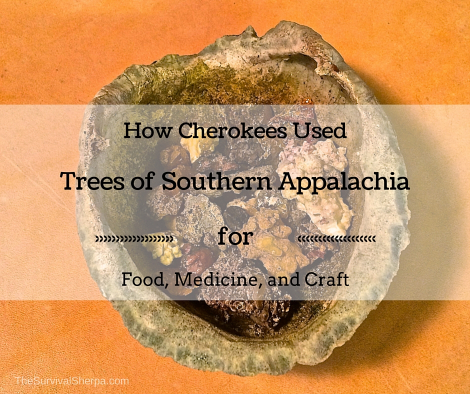





very interesting.